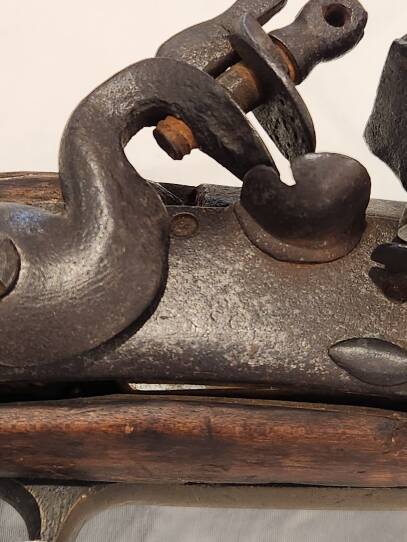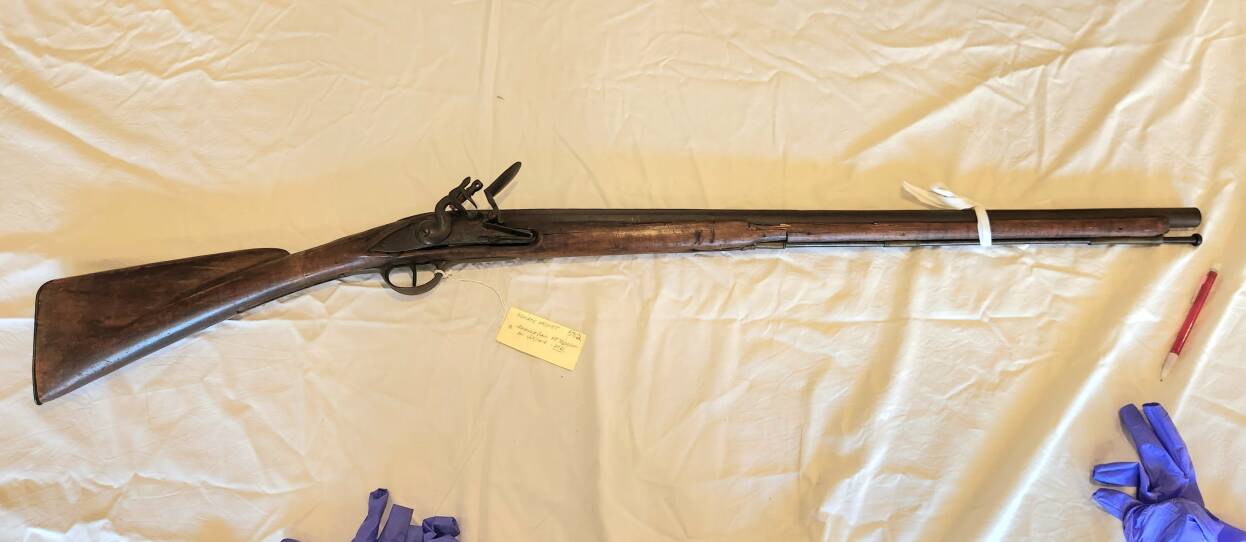The American Revolution’s humble beginnings 250 years ago are reflected in a cut down, beat up, old musket — one that even experts recognize isn’t much to look at.
“If that gun was on a table, everybody would walk by it and not even look at it,” said antique arms appraiser Joel Bohy. “You know, someone might want to buy it for parts or something.”
And yet, because of the story this musket tells, it’s a priceless piece of history.

Lexington History Museums curator Jesse Hilton recently showed off a collection of historic items, including this flintlock musket. It belonged to John Munroe, one of the local residents who fought in the Battle of Lexington, about a mile up the road from the museum.
“We had about 80 men that came and served, or were called to duty,” Hilton said. “And a great representation of that battle is this musket we have here.”
On the morning of April 19, 1775, Munroe, his family, and his neighbors faced down 700 British troops on Lexington Green.
“John Munroe was 27 years old at the time,” Hilton said. “He was a new father, he had two kids. He was called to the Green that day, along with his father, Robert Monroe, and eight other members of the Munroe clan.”
After that first shot rang out, she said, it was chaos.
“His father gets shot and killed. His cousin, who’s right next to him, Ebenezer, gets shot and injured. He watched Jonas Parker, who was a friend of his, get killed,” she said. “And all the while, he’s trying to fight back with this musket.”

The barrel is 30 inches long, but it was originally a foot longer. That’s because, as John Munroe aimed this musket at British troops, it backfired and split the barrel.
“The mark here shows where it would have blown off and where it has been repaired over the years,” Hilton said as she pointed to the barrel.
Miraculously, Munroe wasn’t injured when the gun basically blew up in his hands. And he survived to tell the story and provide a harrowing description of the battle in an 1824 deposition:
“After the second fire from the British troops, I distinctly saw Jonas Parker struggling on the ground, with his gun in his hand, apparently attempting to load it. In this situation, the British came up, run him through with the bayonet, and killed him on the spot.
“After I had fired the first time, I retreated about 10 rods, and then loaded my gun a second time, with two balls. And on firing at the British, the strength of the charge took off about a foot of my gun barrel.”John Munroe, 1824 deposition
Antique arms expert Bohy says it wasn’t unusual that Munroe loaded his musket with two balls. The minutemen were outnumbered, and Munroe probably thought he’d increase his chances of hitting a redcoat that way.
“The only problem is that today, with modern ballistics research, we know that that doesn’t happen,” Bohy explained.
The first ball comes out at significantly reduced velocity, and the second one doesn’t even go far enough to hit most targets. Also, the second ball caused that catastrophic backfire Munroe experienced.

Even when they’re working as designed, loading a musket is a slow and complicated process. Bohy demonstrated all the steps in a new PBS NOVA documentary called “Revolutionary War Weapons,” starting with a paper cartridge filled with gunpowder and a lead ball.
“Take the tail, bite it off, pour some powder into the pan. More gunpowder down the barrel with a musket ball. And we ram that cartridge home, and the gun is loaded and ready to fire,” he explained in the documentary.
Muskets like the one Munroe fired became in short supply as the war picked up, and the colonists needed arms. Men aged 16 to 60 were required to have guns in order to serve in local militias, Bohy explained.
“And that’s one of the things you see in a lot of documents, is Washington constantly struggling,” he said. “George Washington is always trying to get firearms. And a lot of times what they’re getting are older things — until the French step in, and we end up getting a ton of French guns.”
In 1777, 60,000 French arms arrived, changing the course of the war.
“And I think without those guns,” he said, “the revolution would have been over.”




